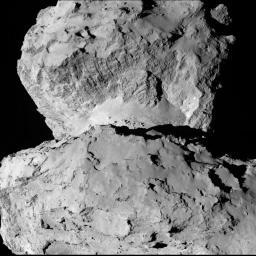
|
Comet Surface Variations
- Click the image above for a larger view
- Full-Res JPEG (2048 x 2048) (534.5 kB)
- Full-Res TIFF (2048 x 2048) (4.2 MB)
Caption:
This image of comet 67P/Churyumov-Gerasimenko shows the diversity of surface structures on the comet's nucleus. It was taken by the Rosetta spacecraft's navigation camera on August 7, 2014. At the time, the spacecraft was 65 miles (104 kilometers) away from the 2.5 mile (4 kilometer) wide nucleus.
In the image, the comet's head (in the top half of the image) exhibits parallel linear features that resemble 'cliffs', and its neck displays scattered boulders on a relatively smooth, slumping, surface. In comparison, the comet's body (lower half of the image) seems to exhibit a multi-variable terrain, with peaks and valleys, and both smooth and rough topographic features.
Launched in March 2004, Rosetta was reactivated in January 2014 after a record 957 days in hibernation. Composed of an orbiter and lander, Rosetta's objectives upon arrival at comet 67P/Churyumov-Gerasimenko in August are to study the celestial object up close in unprecedented detail, prepare for landing a probe on the comet's nucleus in November, and track its changes as it sweeps past the sun.
Comets are time capsules containing primitive material left over from the epoch when the sun and its planets formed. Rosetta's lander will obtain the first images taken from a comet's surface and will provide the first analysis of a comet's composition by drilling into the surface. Rosetta also will be the first spacecraft to witness at close proximity how a comet changes as it is subjected to the increasing intensity of the sun's radiation. Observations will help scientists learn more about the origin and evolution of our solar system and the role comets may have played in seeding Earth with water, and perhaps even life.
Background Info:
Rosetta is an ESA mission with contributions from its member states and NASA. Rosetta's Philae lander is provided by a consortium led by the German Aerospace Center, Cologne; Max Planck Institute for Solar System Research, Gottingen; French National Space Agency, Paris; and the Italian Space Agency, Rome. JPL, a division of the California Institute of Technology, Pasadena, manages the U.S. participation in the Rosetta mission for NASA's Science Mission Directorate in Washington.
For more information on the U.S. instruments aboard Rosetta, visit http://rosetta.jpl.nasa.gov .
More information about Rosetta is available at: http://www.esa.int/rosetta .
For publicly released image use, see ESA's Copyright Notice Images .
Cataloging Keywords:
| Name | Value | Additional Values |
|---|---|---|
| Target | 67P/Churyumov-Gerasimenko | |
| System | Periodic Comets | |
| Target Type | Comet | |
| Mission | Rosetta | |
| Instrument Host | Rosetta Orbiter | Philae Lander |
| Host Type | Orbiter | Lander |
| Instrument | Optical, Spectrocopic and Infrared Remote Imaging System (OSIRIS) | |
| Detector | ||
| Extra Keywords | Grayscale, Water | |
| Acquisition Date | ||
| Release Date | 2014-08-14 | |
| Date in Caption | 2014-08-07 | |
| Image Credit | Copyright: ESA/Rosetta/MPS for OSIRIS Team MPS/UPD/LAM/IAA/SSO/INTA/UPM/DASP/IDA | |
| Source | photojournal.jpl.nasa.gov/catalog/PIA18596 | |
| Identifier | PIA18596 | |
